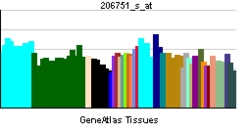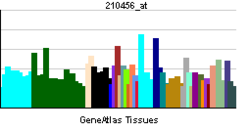- PCYT1B
-
Phosphate cytidylyltransferase 1, choline, beta Identifiers Symbols PCYT1B; CCTB; CTB External IDs OMIM: 604926 MGI: 2147987 HomoloGene: 3564 GeneCards: PCYT1B Gene EC number 2.7.7.15 Gene Ontology Molecular function • choline-phosphate cytidylyltransferase activity
• transferase activity
• nucleotidyltransferase activityCellular component • cytoplasm
• endoplasmic reticulumBiological process • ovarian follicle development
• phosphatidylcholine biosynthetic process
• CDP-choline pathway
• spermatogenesis
• phospholipid biosynthetic process
• biosynthetic processSources: Amigo / QuickGO RNA expression pattern 

More reference expression data Orthologs Species Human Mouse Entrez 9468 236899 Ensembl ENSG00000102230 ENSMUSG00000035246 UniProt Q9Y5K3 Q811Q9 RefSeq (mRNA) NM_001163264.1 NM_177546 RefSeq (protein) NP_001156736.1 NP_808214 Location (UCSC) Chr X:
24.58 – 24.69 MbChr X:
90.9 – 91 MbPubMed search [1] [2] Choline-phosphate cytidylyltransferase B is an enzyme that in humans is encoded by the PCYT1B gene.[1][2]
References
- ^ Lykidis A, Murti KG, Jackowski S (Jul 1998). "Cloning and characterization of a second human CTP:phosphocholine cytidylyltransferase". J Biol Chem 273 (22): 14022–9. doi:10.1074/jbc.273.22.14022. PMID 9593753.
- ^ "Entrez Gene: PCYT1B phosphate cytidylyltransferase 1, choline, beta". http://www.ncbi.nlm.nih.gov/sites/entrez?Db=gene&Cmd=ShowDetailView&TermToSearch=9468.
Further reading
- Gerhard DS, Wagner L, Feingold EA, et al. (2004). "The status, quality, and expansion of the NIH full-length cDNA project: the Mammalian Gene Collection (MGC)". Genome Res. 14 (10B): 2121–7. doi:10.1101/gr.2596504. PMC 528928. PMID 15489334. http://www.pubmedcentral.nih.gov/articlerender.fcgi?tool=pmcentrez&artid=528928.
- Ballif BA, Villén J, Beausoleil SA, et al. (2005). "Phosphoproteomic analysis of the developing mouse brain". Mol. Cell Proteomics 3 (11): 1093–101. doi:10.1074/mcp.M400085-MCP200. PMID 15345747.
- Ota T, Suzuki Y, Nishikawa T, et al. (2004). "Complete sequencing and characterization of 21,243 full-length human cDNAs". Nat. Genet. 36 (1): 40–5. doi:10.1038/ng1285. PMID 14702039.
- Strausberg RL, Feingold EA, Grouse LH, et al. (2003). "Generation and initial analysis of more than 15,000 full-length human and mouse cDNA sequences". Proc. Natl. Acad. Sci. U.S.A. 99 (26): 16899–903. doi:10.1073/pnas.242603899. PMC 139241. PMID 12477932. http://www.pubmedcentral.nih.gov/articlerender.fcgi?tool=pmcentrez&artid=139241.
- Llorca O, Martín-Benito J, Gómez-Puertas P, et al. (2002). "Analysis of the interaction between the eukaryotic chaperonin CCT and its substrates actin and tubulin". J. Struct. Biol. 135 (2): 205–18. doi:10.1006/jsbi.2001.4359. PMID 11580270.
- McCormack EA, Llorca O, Carrascosa JL, et al. (2002). "Point mutations in a hinge linking the small and large domains of beta-actin result in trapped folding intermediates bound to cytosolic chaperonin CCT". J. Struct. Biol. 135 (2): 198–204. doi:10.1006/jsbi.2001.4385. PMID 11580269.
- Lykidis A, Baburina I, Jackowski S (1999). "Distribution of CTP:phosphocholine cytidylyltransferase (CCT) isoforms. Identification of a new CCTbeta splice variant". J. Biol. Chem. 274 (38): 26992–7001. doi:10.1074/jbc.274.38.26992. PMID 10480912.
- Gubin AN, Njoroge JM, Bouffard GG, Miller JL (1999). "Gene expression in proliferating human erythroid cells". Genomics 59 (2): 168–77. doi:10.1006/geno.1999.5855. PMID 10409428.
Categories:- Human proteins
- Chromosome X gene stubs
Wikimedia Foundation. 2010.
